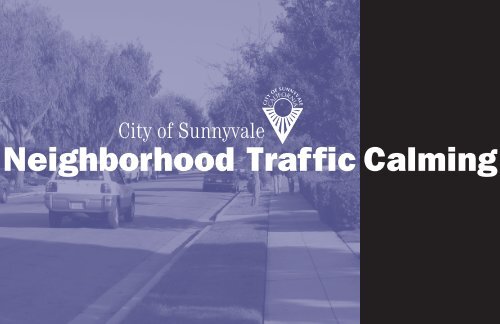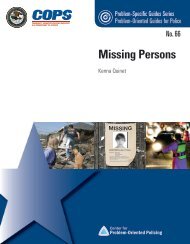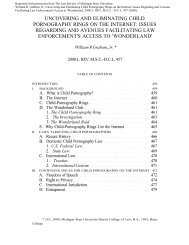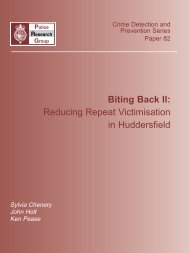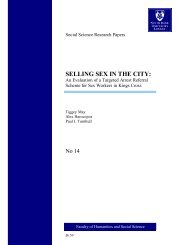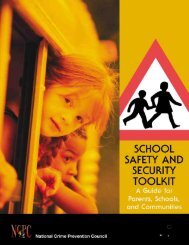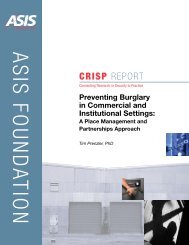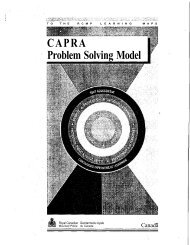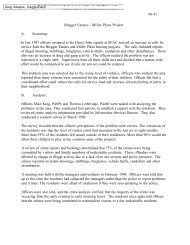You also want an ePaper? Increase the reach of your titles
YUMPU automatically turns print PDFs into web optimized ePapers that Google loves.
City of Sunnyvale<br />
<strong>Neighborhood</strong> <strong>Traffic</strong> <strong>Calming</strong>
City of Sunnyvale<br />
<strong>Neighborhood</strong> <strong>Traffic</strong> <strong>Calming</strong><br />
Department of Public Works
Division of Transportation and <strong>Traffic</strong><br />
Department of Public Works<br />
City of Sunnyvale<br />
P.O. Box 3707<br />
Sunnyvale, CA 94088-3707<br />
(408) 731-7415 Conceptual designs Provided by Fehr and Peers Transportation Consultants.
Table of Contents 1<br />
Table of<br />
of<br />
Contents<br />
Contents<br />
What is <strong>Traffic</strong> <strong>Calming</strong>?................................................................................................... 2<br />
What are <strong>Traffic</strong> <strong>Calming</strong> Measures? ............................................................................. 2<br />
The <strong>Neighborhood</strong> <strong>Traffic</strong> <strong>Calming</strong> Process .................................................................. 3<br />
Step 1 — Report the Problem ............................................................................ 3<br />
Step 2 — <strong>Neighborhood</strong> Consensus ................................................................... 4<br />
Step 3 — Data Collection.................................................................................... 4<br />
Step 4 — Stage 1 <strong>Traffic</strong> <strong>Calming</strong> ...................................................................... 5<br />
Step 5 — Follow-up Data Collection.................................................................. 6<br />
Step 6 — Stage 2 <strong>Traffic</strong> <strong>Calming</strong> Study ........................................................... 6<br />
Step 7 — City Council Approval......................................................................... 12<br />
Prioritization......................................................................................................... 12<br />
Pros and Cons of Stage 2 <strong>Traffic</strong> <strong>Calming</strong>..................................................................... 13<br />
<strong>Traffic</strong> <strong>Calming</strong> Request Form ......................................................................................... 20<br />
<strong>Neighborhood</strong> Petition Form ............................................................................................ 21<br />
Appendix 1 — <strong>Traffic</strong> <strong>Calming</strong> Flow Chart ...................................................................... 23<br />
Appendix 2 — Sunnyvale Roadway Classification Map.................................................. 24
2 City of Sunnyvale — <strong>Neighborhood</strong> <strong>Traffic</strong> <strong>Calming</strong><br />
What is <strong>Traffic</strong> <strong>Calming</strong>?<br />
What is <strong>Traffic</strong> <strong>Calming</strong>?<br />
Sunnyvale residents have expressed concern about speeding and cut-through traffic in<br />
residential neighborhoods. In response to public interest the City has developed a<br />
<strong>Neighborhood</strong> <strong>Traffic</strong> <strong>Calming</strong> Policy.<br />
The Institute of Transportation Engineers defines “traffic calming” as “the combination of<br />
mainly physical measures that reduce the negative effects of motor vehicle use, alter<br />
driver behavior, and improve conditions for non-motorized street users.”<br />
The City of Sunnyvale also expands this definition to include non-physical measures such<br />
as educational programs and enhanced enforcement.<br />
What are <strong>Traffic</strong><br />
<strong>Calming</strong> Measures?<br />
What are <strong>Traffic</strong> <strong>Calming</strong> Measures?<br />
<strong>Neighborhood</strong> traffic calming measures are an attempt to enhance traffic and pedestrian<br />
safety and preserve neighborhood character and livability. There are a number of traffic<br />
calming devices that are available to achieve this effect. The specific measures are<br />
described in more detail below, but can generally be used to address problems with<br />
speeding, cut-through traffic, increased volume, and safety. When a traffic calming<br />
measure is implemented successfully, it is effective and self enforcing.
The <strong>Neighborhood</strong> <strong>Traffic</strong> <strong>Calming</strong> Process 3<br />
The <strong>Neighborhood</strong><br />
<strong>Neighborhood</strong> <strong>Traffic</strong><br />
<strong>Traffic</strong> <strong>Calming</strong> Process<br />
<strong>Calming</strong> Process?<br />
This section describes the process, regulations, and requirements of the Sunnyvale<br />
<strong>Neighborhood</strong> <strong>Traffic</strong> <strong>Calming</strong> Policy. For a brief overview of the process, see the <strong>Traffic</strong><br />
<strong>Calming</strong> flow chart (Appendix 1).<br />
STEP 1 — Report the Problem<br />
If you feel as though you have a speeding or traffic problem on your residential street, the<br />
first step is to report the problem to City of Sunnyvale Transportation & <strong>Traffic</strong> staff at<br />
(408) 730-7415 or pubworks@ci.sunnyvale.ca.us. City staff will note your complaint and<br />
provide a <strong>Traffic</strong> <strong>Calming</strong> Request Form. This form will also be available at<br />
www.ci.sunnyvale.ca.us/public-works/traffic.htm. When the form is submitted City staff<br />
will evaluate the complaint to determine the nature of the problem, and make sure that<br />
the location meets the first traffic calming criteria:<br />
The street must be classified as “Residential.”<br />
The City will not implement traffic calming measures, or conduct traffic calming studies<br />
on “arterial” or “residential collector” streets. Please see Appendix 2 for the City’s<br />
“Roadway Classification Map.” Staff can work with you to identify other actions if your<br />
street does not meet this basic criterion.
4 City of Sunnyvale — <strong>Neighborhood</strong> <strong>Traffic</strong> <strong>Calming</strong><br />
STEP 2 — <strong>Neighborhood</strong> Consensus<br />
After the initial report, City staff will request a petition from a representative number of<br />
residents in the neighborhood to verify that there is a widespread concern for the<br />
speeding or traffic issue. After the petition is received it will be reviewed by City staff.<br />
Sunnyvale staff will be<br />
happy to discuss the traffic<br />
calming policy in person<br />
at a neighborhood or<br />
homeowners association<br />
meeting.<br />
STEP 3 — Data Collection<br />
When it is determined that a representative number of residents perceive the problem,<br />
City staff will collect traffic volume and speed data for the street and observe traffic<br />
patterns.<br />
Speeding Problem Thresholds:<br />
■ If 85% of the vehicles driving on the roadway are traveling at speeds above 32 miles<br />
per hour then the street would be eligible for <strong>Traffic</strong> <strong>Calming</strong>.<br />
■ Additionally, in some situations the residents concern is for the few drivers<br />
considerably exceeding the speed limit. In this case, a 95th Percentile speed of 35 miles<br />
per hour would be used as a threshold instead.<br />
Cut-through Problem Threshold:<br />
■ In some cases, the reported problem is related to the volume of traffic on the<br />
residential street instead of the speed. If the street carries more than 1000 vehicles per<br />
day, then the street would be eligible for <strong>Traffic</strong> <strong>Calming</strong>.
The <strong>Neighborhood</strong> <strong>Traffic</strong> <strong>Calming</strong> Process 5<br />
Other Issues:<br />
■ Some traffic problems do not fit neatly into the speeding or cut-through “boxes”. City<br />
staff will evaluate on a case-by-case basis if a unique issue warrants traffic calming.<br />
STEP 4 — Stage 1 <strong>Traffic</strong> <strong>Calming</strong><br />
If the trouble location exceeds the thresholds identified above, City staff will first suggest<br />
possible solutions that do not involve the use of physical controls or impediments on the<br />
roadway system. These are primarily education and enforcement based measures called<br />
Stage 1 traffic calming. These include:<br />
■ Radar Speed Trailer Deployment — This is a temporary device that is primarily used<br />
to educate motorists regarding the fact that they may be significantly exceeding the<br />
posted speed limit.<br />
■ <strong>Traffic</strong> Enforcement Actions — This is traditional enforcement activity on the part of<br />
Public Safety’s traffic enforcement officers. The intent is to modify behavior to result<br />
in a safer situation for all drivers and neighbors.<br />
■ <strong>Traffic</strong> Signing and Pavement Markers — <strong>Traffic</strong> Engineering staff will review all of<br />
the traffic signing and pavement markings in the area. If necessary, staff will install<br />
additional signing or striping. When appropriate, changes and additions will be<br />
reviewed with interested neighbors.
6 City of Sunnyvale — <strong>Neighborhood</strong> <strong>Traffic</strong> <strong>Calming</strong><br />
STEP 5 — Follow-up Data Collection<br />
Sometimes residents of the<br />
neighborhood contribute<br />
significantly to a speeding<br />
problem. In this case, a<br />
grassroots citizen-driven<br />
awareness campaign can<br />
be very effective.<br />
If one or more of the Stage 1 <strong>Traffic</strong> <strong>Calming</strong> measures is implemented City staff will wait<br />
approximately three to six months and conduct another speed and/or volume data<br />
collection. The data will then be analyzed to determine if the <strong>Traffic</strong> <strong>Calming</strong> measure was<br />
successful. If the measure was successful, and the thresholds identified in Step 3 are not<br />
exceeded then the traffic calming process will end at this point.<br />
If the location continues to exceed the thresholds for speed and/or volume on a residential<br />
street, City staff will move on to analyze possible Stage 2 <strong>Traffic</strong> <strong>Calming</strong> methods.<br />
STEP 6 — Stage 2 <strong>Traffic</strong> <strong>Calming</strong> Study<br />
City staff will conduct a formal <strong>Traffic</strong> <strong>Calming</strong> Study to suggest possible solutions to the<br />
problem. The solutions could involve physical modifications of the street intended to<br />
control traffic speeds and/or volumes. These are called Stage 2 traffic calming methods.<br />
<strong>Neighborhood</strong> involvement will be a large part of the <strong>Traffic</strong> <strong>Calming</strong> Study process.
The <strong>Neighborhood</strong> <strong>Traffic</strong> <strong>Calming</strong> Process 7<br />
Possible Stage 2 methods include:<br />
■ Speed Humps<br />
Speed humps are approximately 12 feet in width and vary from 2.5 to 4 inches in height.<br />
This raised pavement serves to physically force motorists to reduce their speed. In<br />
order to be effective, speed humps should be placed no further than 300 feet apart.<br />
See Figure 1.<br />
■ Speed Tables<br />
These are speed humps with a long flat section that are generally used at crosswalk<br />
locations. Both speed humps and speed tables require signing and roadway markings<br />
to make their presence known to motorists and other roadway users.<br />
See Figure 2.<br />
FIGURE 1<br />
FIGURE 2
8 City of Sunnyvale — <strong>Neighborhood</strong> <strong>Traffic</strong> <strong>Calming</strong><br />
■ <strong>Traffic</strong> Circles<br />
This device is a raised circular island in the middle of a residential neighborhood<br />
intersection. Direct straight through movements are obstructed by the raised island<br />
causing traffic to move to the right and around the circle. The intersection approaches<br />
are normally controlled by yield signs that serve to alert motorists to the need to slow<br />
their speed entering the intersection.<br />
See Figure 3.<br />
FIGURE 3<br />
■ Curb Extensions, Chokers, Chicanes<br />
These are various methods of narrowing the roadway by extending raised curbs into the<br />
street. These can be done at street entries and exits as well as mid-block locations. The<br />
narrower street generally results in reduced traffic speeds and provides pedestrians<br />
with shorter crossing distances.<br />
See Figure 4.<br />
■ Median Entry/Exit Islands<br />
These are traffic islands used to create narrower roadway passages at entry and<br />
exit points.<br />
FIGURE 4
The <strong>Neighborhood</strong> <strong>Traffic</strong> <strong>Calming</strong> Process 9<br />
■ Median Barriers<br />
These can be a barrier or raised island along the center of a roadway to prohibit left<br />
turns or crossing traffic.<br />
See Figure 5.<br />
■ Mid-Block Raised Medians<br />
This is a median placed in the center of a roadway to create a narrower travel way and<br />
also reduce pedestrian crossing distances.<br />
See Figure 6.<br />
FIGURE 5<br />
FIGURE 6
10 City of Sunnyvale — <strong>Neighborhood</strong> <strong>Traffic</strong> <strong>Calming</strong><br />
■ Forced Turn Islands, Barriers, Channelization<br />
These are traffic islands or curbs specifically designed to prevent traffic from making<br />
specific movements at an intersection.<br />
See Figure 7.<br />
■ Diagonal Diverters<br />
These are barriers placed diagonally across an intersection to force drivers to make a<br />
particular turn but not allow other movements.<br />
See Figure 8.<br />
FIGURE 7<br />
■ One-Way Streets<br />
This is when traffic on a street is regulated to only allow traffic to flow in one direction.<br />
Usually this is accomplished through sign placement.<br />
FIGURE 8
The <strong>Neighborhood</strong> <strong>Traffic</strong> <strong>Calming</strong> Process 11<br />
■ One-Way Chokers, Half-Closures or Semi-Diverters<br />
These are barriers to traffic in one direction that permit traffic in the opposite<br />
direction to proceed.<br />
See Figure 9.<br />
■ Woonerf<br />
This is a design that makes residential streets an extension of the front yards.<br />
Essentially there is no identified street with curbs and gutters. Parked cars,<br />
landscaping, etc. intrude upon portions of the streetway while still allowing for<br />
vehicular travel. They are typically narrow streets without curbs and sidewalks, and<br />
vehicles are slowed by placing trees, planters, parking areas, and other obstacles in the<br />
street. Motorists become the intruders and must travel at very low speeds below 16<br />
km/h (10 mi/h). This makes a street available for public use that is essentially only<br />
intended for local residents.<br />
FIGURE 9<br />
■ Street Closures and Cul-de-sacs<br />
This is the complete barricade or termination of a street.<br />
See Figure 10.<br />
FIGURE 10
12 City of Sunnyvale — <strong>Neighborhood</strong> <strong>Traffic</strong> <strong>Calming</strong><br />
The following general criteria must be met to consider the installation of any Stage 2<br />
traffic calming measure:<br />
1. Installation must not result in traffic diversion to other neighborhood streets.<br />
2. At least 60% of the impacted residents and 100% of the residents within 100 feet of the<br />
proposed device shall support the installation.<br />
3. Devices shall be located a minimum of 25 feet from driveways, manholes, drain inlets,<br />
water valves, street monuments, and other appurtenances.<br />
4. Devices shall be located a minimum of 25 feet from fire hydrants.<br />
5. Devices shall be installed only where a minimum safe stopping distance can be<br />
provided.<br />
6. Sunnyvale Department of Public Safety must approve the plan to assure that<br />
emergency response times or access are not negatively effected.<br />
STEP 7 — City Council Approval<br />
Once City staff and the neighborhood agree on an appropriate <strong>Traffic</strong> <strong>Calming</strong> solution,<br />
the proposal will be brought to the City Council for final approval and funding allocation.<br />
This process will include a formal Public Hearing.<br />
Prioritization<br />
Staff will complete <strong>Traffic</strong> <strong>Calming</strong> Studies on a “first come -first serve” basis.
The Pros and Cons of Stage 2 <strong>Traffic</strong> <strong>Calming</strong> 13<br />
The Pros and<br />
Pros<br />
Cons<br />
and Cons of<br />
of Stage 2 <strong>Traffic</strong> <strong>Calming</strong><br />
Stage 2 <strong>Traffic</strong> <strong>Calming</strong><br />
Before the City decides to consider pursuing Stage 2 traffic calming actions, it is important<br />
that the benefits and disadvantages be carefully considered. While Stage 2 actions can be<br />
successful, they can also result in problems more significant than the original concern.<br />
This section will describe the pros and cons of the Stage 2 traffic calming tools described<br />
previously. In most cases, the benefits are predictable, while the disadvantages can be<br />
much more unexpected. Consequently, a greater emphasis has been placed on the<br />
potential problems so that decisions can be made in a fully informed manner.<br />
Pros<br />
■ <strong>Traffic</strong> <strong>Calming</strong> Measures Often Achieve the Desired Result<br />
Physical actions such as the installation of speed humps, traffic circles, street closures,<br />
etc. are almost always successful in forcing traffic to behave in an intended fashion. In<br />
certain situations, they can achieve the desired result by utilizing a one time capital<br />
expenditure and generally low ongoing maintenance costs.
14 City of Sunnyvale — <strong>Neighborhood</strong> <strong>Traffic</strong> <strong>Calming</strong><br />
■ Permanence<br />
Stage 2 traffic calming actions are generally viewed as much more permanent solutions<br />
that Stage 1 actions. In most instances the alternative approach to the desired result<br />
involves repetitive and costly ongoing Stage 1 traffic calming actions. There are<br />
significant potential benefits to utilizing State 2 traffic calming actions which is why<br />
some communities have implemented Stage 2 actions and many other communities are<br />
exploring their possible use.<br />
■ Accident and Crash Reduction<br />
One of the most important impacts of traffic calming is the potential reduction in the<br />
severity and number of crashes on traffic-calmed streets. Safety is enhanced through<br />
increased driver awareness of other street users and reductions in volumes, speeds and<br />
conflicts. In the United States, reduction of crashes due to traffic calming measures<br />
has been reported to be an overall average of 50 percent. <strong>Traffic</strong> circles appear to offer<br />
the greatest reduction in collisions. Speed reduction is especially important for<br />
pedestrian safety, as the severity of injury to a pedestrian when hit by an automobile is<br />
dramatically reduced by lowering vehicle speeds from 35 mph (usually fatal) to fewer<br />
than 20 mph (usually just minor injuries).<br />
■ Increased <strong>Neighborhood</strong> Property Values<br />
Many measures provide for landscaping opportunities in formerly paved areas, thus<br />
contributing positively to neighborhood aesthetics. There is some evidence that a well<br />
designed traffic calming project can increase neighborhood property values.
The Pros and Cons of Stage 2 <strong>Traffic</strong> <strong>Calming</strong> 15<br />
Cons<br />
■ Delays in Emergency Response Vehicles<br />
This is especially true for fire apparatus and ambulance. Because of the heavy weight<br />
of fire engines, and delicate instruments and patients within ambulances, these<br />
vehicles must almost come to a complete stop when they encounter a bump, dip or<br />
sharp curve. Creating bumps, dips, and sharp curves is often precisely the result of<br />
many of the traffic calming tools. While these maneuvers will cause moderate discomfort<br />
and delay for normal passenger vehicles, they cause a much greater problem for<br />
emergency vehicles.<br />
The time required to respond to medical emergencies or building fires by emergency<br />
personnel and apparatus has a significant influence on the outcome of the event. In<br />
cardiac arrest cases, literally seconds count in the patient’s chance of survival. From<br />
the moment of collapse, the likelihood for recovery diminished by 10% for each minute<br />
which passes. Likewise, in their early stages, fires grow at a geometric rate. Minutes<br />
could mean the difference between a small fire easily contained and a fire causing<br />
major property loss and possible injury or death. For these reasons, the City’s Fire<br />
Services Division is concerned with any physical action which would force delay upon<br />
responding emergency vehicles.
16 City of Sunnyvale — <strong>Neighborhood</strong> <strong>Traffic</strong> <strong>Calming</strong><br />
■ Diverting the “Problem” <strong>Traffic</strong> to Another <strong>Neighborhood</strong> Street<br />
Another concern has been the realization that in many instances implementing traffic<br />
calming tools would be likely to move the problem rather than solve the problem. In<br />
virtually all instances, the traffic being controlled by physical traffic calming tools will<br />
not disappear or make major changes in its travel patterns. In most instances the<br />
placing of impediments on a particular neighborhood street will merely divert some or<br />
all of that traffic to other neighborhood streets.<br />
■ Everyone is Inconvenienced<br />
Enforcement and education efforts aimed at controlling speeds or influence driver<br />
behavior impact primarily the irresponsible drivers - usually a relatively small<br />
percentage of the driving population. On the other hand, physical traffic calming<br />
measures create delay and inconvenience for all drivers using the particular street.
The Pros and Cons of Stage 2 <strong>Traffic</strong> <strong>Calming</strong> 17<br />
■ Benefits Sometimes Very Localized<br />
While speed humps are generally very effective in reducing speed in the immediate<br />
vicinity of the humps, they often result in higher speeds between the humps as drivers<br />
try to “make up” for the delay at the humps. Consequently, while using the speed<br />
humps to lower the average speed, it is likely that the top speeds on the street will<br />
increase. This result has been clearly documented in many studies regarding the use of<br />
speed humps or non-warranted stop signs for speed control.<br />
Other Stage 2 traffic calming actions can also result in benefits near the installation<br />
but disadvantages elsewhere within a neighborhood. In the case of neighborhood<br />
intersection traffic circles, the results are often similar to speed humps with drivers<br />
traveling at higher velocity between the circles to “make up” the lost time. Actions such<br />
as diverters, barriers, and medians can often improve the situation where the traffic<br />
movement has been prohibited but can significantly worsen the problems to the streets<br />
where the traffic has been diverted.<br />
■ Actions can be Significant for Certain Types of Vehicles<br />
Speed humps can significantly increase the cost of maintaining heavy vehicles. While<br />
not readily quantifiable, this is an important consideration related to the maintenance<br />
cost for fire engines, refuse trucks, etc. This is an especially serious concern for<br />
vehicles which will confront the traffic calming actions on a continual or repeated<br />
basis.
18 City of Sunnyvale — <strong>Neighborhood</strong> <strong>Traffic</strong> <strong>Calming</strong><br />
■ Impacts on Parking and Other Road Users<br />
Bicyclists, pedestrians and any other road user can encounter problems with physical<br />
traffic calming measures. All measures are designed to be acceptably safe for all users,<br />
assuming that these users are attentive as the proceed down the street. Speed humps<br />
and traffic circles, for example, are two of the most popular traffic calming measures.<br />
Bicyclists can traverse speed humps at typical cycling speeds without slowing down.<br />
However, if the bicyclists is careless (e.g., riding with no hands, not watching the road,<br />
no lights at night, etc.), the bicyclist might unexpectedly encounter a hump and be<br />
caught off balance. Where lanes are narrowed, bicyclists and drivers usually must share<br />
the lane, possibly becoming a problem if traffic volumes are moderate to high. <strong>Traffic</strong><br />
circles force drivers to the right at intersections, toward (but not into) the crosswalks,<br />
and pedestrians sometimes feel that their safety is being compromised. Residents who<br />
are used to parking in front of their homes on the street may also be impacted, as some<br />
measures require the prohibition of on-street parking. These disadvantages for various<br />
user groups need to be considered along with the recognized benefits of overall traffic<br />
speed and volume reduction that result from a traffic calming project.
The Pros and Cons of Stage 2 <strong>Traffic</strong> <strong>Calming</strong> 19<br />
■ Visual Impacts, Noise Impacts and Aesthetic Concerns<br />
While some traffic calming devices can have favorable aesthetic impacts, others can be,<br />
by their nature, unsightly. Actions such as speed humps and diverters most often pose<br />
no opportunity for the incorporation of aesthetics and can certainly have negative visual<br />
impacts. Additionally, virtually all Stage 2 traffic calming devices require reflective<br />
devices, signs and striping which negatively effect the aesthetics of a neighborhood.<br />
Since these devices are intended to pose obstacles to cars, they must be very well<br />
signed, marked and lit in order to minimized potential safety problems and potential<br />
liability exposure. While the signing, marking and lighting are clearly justified for those<br />
reasons, they certainly negatively impact neighborhood aesthetics.<br />
Noise in the area of traffic calming devices, such as speed humps, can increase due to<br />
the deceleration and acceleration of vehicles. There is also usually noise created by the<br />
vehicle traversing a speed hump.<br />
The City considers the balance of the <strong>Traffic</strong> <strong>Calming</strong> pros and cons and recognizes that<br />
there are situations where the benefits of traffic calming outweigh the disadvantages.<br />
With each individual <strong>Neighborhood</strong> <strong>Traffic</strong> <strong>Calming</strong> Study that is conducted, City staff<br />
and residents must carefully weigh these advantages and disadvantages of each traffic<br />
calming action.
20 City of Sunnyvale — <strong>Neighborhood</strong> <strong>Traffic</strong> <strong>Calming</strong><br />
<strong>Traffic</strong> <strong>Calming</strong><br />
<strong>Traffic</strong> <strong>Calming</strong><br />
Request Form<br />
Form<br />
This form is to enable neighborhoods<br />
to request the possible<br />
initiation of a traffic calming<br />
study in accordance with the City<br />
of Sunnyvale <strong>Traffic</strong> <strong>Calming</strong><br />
Policy. Please fill out the form<br />
and Submit it to:<br />
The City of Sunnyvale<br />
DPW — <strong>Traffic</strong> Engineering<br />
456 West Olive Avenue<br />
Sunnyvale, CA 94088<br />
Attn: <strong>Traffic</strong> <strong>Calming</strong><br />
1. Contact Information<br />
Name: _______________________________________________________________________________<br />
Address: _____________________________________________________________________________<br />
Phone Number: _______________________________________________________________________<br />
Email:________________________________________________________________________________<br />
2. Please describe the location of the traffic concern. Attach a map or picture if necessary:<br />
_________________________________________________________________________________________________<br />
_________________________________________________________________________________________________<br />
3. Please describe the nature of the neighborhood problem you are concerned with (attach<br />
additional sheets if necessary):<br />
_________________________________________________________________________________________________<br />
_________________________________________________________________________________________________<br />
_________________________________________________________________________________________________<br />
_________________________________________________________________________________________________<br />
4. Please list possible solutions to the problem that you would like the City of Sunnyvale<br />
to consider:<br />
_________________________________________________________________________________________________<br />
_________________________________________________________________________________________________<br />
_________________________________________________________________________________________________<br />
_________________________________________________________________________________________________
<strong>Neighborhood</strong> Petition Form 21<br />
<strong>Neighborhood</strong><br />
Petition Form<br />
City of Sunnyvale – Petition for <strong>Neighborhood</strong> <strong>Traffic</strong> <strong>Calming</strong> Measures<br />
THE UNDERSIGNED AGREE TO THE FOLLOWING:<br />
1. All persons signing this petition do hereby certify that they reside within the impacted area,<br />
which is hereby defined as the street segment of:<br />
_________________________________________________________________________________________________<br />
_________________________________________________________________________________________________<br />
_________________________________________________________________________________________________<br />
2. All persons signing this petition do hereby agree of the following problem in the defined<br />
impacted area:<br />
_________________________________________________________________________________________________<br />
_________________________________________________________________________________________________<br />
_________________________________________________________________________________________________<br />
3. All persons signing this petition do hereby agree that the following contact person(s) represent<br />
the neighborhood as facilitator(s) between the neighborhood residents and the City of<br />
Sunnyvale staff in matters pertaining to items 1 and 2 above:<br />
<strong>Neighborhood</strong><br />
Petition Form<br />
Name Address Phone #<br />
Name Address Phone #<br />
Name Address Phone #<br />
Use back side for Signatures...
22 City of Sunnyvale — <strong>Neighborhood</strong> <strong>Traffic</strong> <strong>Calming</strong><br />
Only One Signature Per Address<br />
1. Name (print) Address Phone Signature<br />
2. Name (print) Address Phone Signature<br />
3. Name (print) Address Phone Signature<br />
4. Name (print) Address Phone Signature<br />
5. Name (print) Address Phone Signature<br />
6. Name (print) Address Phone Signature<br />
7. Name (print) Address Phone Signature<br />
8. Name (print) Address Phone Signature<br />
9. Name (print) Address Phone Signature<br />
10. Name (print) Address Phone Signature<br />
11. Name (print) Address Phone Signature<br />
12. Name (print) Address Phone Signature
Appendix 1 — <strong>Traffic</strong> <strong>Calming</strong> Flow Chart 23<br />
Appendix 1 – <strong>Traffic</strong> <strong>Calming</strong> Flow Chart<br />
<strong>Traffic</strong> <strong>Calming</strong> Flow Chart<br />
Report the concern.<br />
Complete <strong>Traffic</strong> <strong>Calming</strong><br />
Request Form.<br />
Is the location eligible for <strong>Traffic</strong> <strong>Calming</strong>?<br />
YES<br />
NO<br />
City Staff will work with residents<br />
to identify other actions.<br />
Study complete.<br />
Continue <strong>Traffic</strong> <strong>Calming</strong> Study.<br />
<strong>Traffic</strong> <strong>Calming</strong> deemed<br />
inappropriate.<br />
or<br />
NO<br />
NO<br />
NO<br />
NO<br />
NO<br />
Is there neighborhood consensus?<br />
Staff data collection and evaluation. Are thresholds exceeded?<br />
YES<br />
YES<br />
Stage 1 <strong>Traffic</strong> <strong>Calming</strong> implementation.<br />
YES<br />
Follow up data collection.<br />
Are thresholds still exceeded?<br />
YES<br />
Stage 2 <strong>Traffic</strong> <strong>Calming</strong> Study.<br />
YES<br />
Is there neighborhood consensus?<br />
YES<br />
City Council approval.<br />
YES<br />
Implementation.
24 Appendix 2 — Sunnyvale Roadway Classification Map<br />
Classification<br />
Map<br />
Appendix 2 —<br />
Sunnyvale Roadway Classification Map
Notes 25<br />
Notes<br />
Notes
26 City of Sunnyvale — <strong>Neighborhood</strong> <strong>Traffic</strong> <strong>Calming</strong><br />
Notes<br />
Notes
Printed on recycled paper. 12/02


